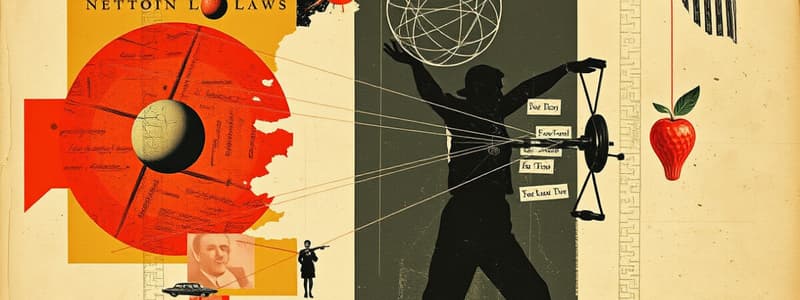Podcast
Questions and Answers
What does the First Law of Motion describe?
What does the First Law of Motion describe?
- The acceleration of an object due to an external force.
- The interaction forces between two objects.
- The tendency of objects to resist changes in their state of motion. (correct)
- The relationship between mass and force on an object.
Which formula represents the Second Law of Motion?
Which formula represents the Second Law of Motion?
- F = mv^2
- F = m + a
- F = ma (correct)
- F = m/a
What is a practical application of the Third Law of Motion?
What is a practical application of the Third Law of Motion?
- Analyzing the motion of planets in their orbits.
- Understanding how rockets propel into space. (correct)
- Calculating the weight of an object.
- Determining the equilibrium of a static object.
Which statement correctly describes the implications of Newton's Laws of Motion?
Which statement correctly describes the implications of Newton's Laws of Motion?
How does the Second Law of Motion define the relationship between force and mass?
How does the Second Law of Motion define the relationship between force and mass?
Flashcards are hidden until you start studying
Study Notes
Newton's Laws of Motion
-
First Law of Motion (Law of Inertia)
- An object at rest stays at rest, and an object in motion stays in motion at a constant velocity, unless acted upon by a net external force.
- This law defines inertia: the tendency of an object to resist changes in its state of motion.
-
Second Law of Motion (Law of Acceleration)
- The acceleration of an object is directly proportional to the net force acting on it and inversely proportional to its mass.
- Formula: ( F = ma )
- ( F ) = force (in Newtons)
- ( m ) = mass (in kilograms)
- ( a ) = acceleration (in meters per second squared)
- This law explains how the velocity of an object changes when it is subjected to external forces.
-
Third Law of Motion (Action and Reaction)
- For every action, there is an equal and opposite reaction.
- This means that forces always occur in pairs: when object A exerts a force on object B, object B exerts an equal and opposite force on object A.
- This principle is crucial in understanding interactions between objects.
Applications of Newton's Laws
- First Law is fundamental in understanding static and dynamic equilibrium.
- Second Law is used to calculate forces in systems (e.g., vehicles, machinery) and is essential in engineering.
- Third Law explains phenomena such as rocket propulsion and swimming.
Implications
- These laws form the basis for classical mechanics, influencing various fields such as engineering, astronomy, and biomechanics.
- They highlight the relationship between force, mass, and motion, providing a framework for analyzing physical interactions.
Newton's Laws of Motion
-
First Law of Motion (Law of Inertia)
- An object at rest remains at rest and an object in motion continues moving at a constant velocity unless influenced by an external force.
- Inertia is the property of matter that quantifies an object's resistance to changes in motion.
-
Second Law of Motion (Law of Acceleration)
- Acceleration is directly proportional to the net force applied and inversely proportional to the object's mass.
- The formula of this law is represented as ( F = ma ), where:
- ( F ) signifies force measured in Newtons.
- ( m ) denotes mass measured in kilograms.
- ( a ) stands for acceleration measured in meters per second squared.
- This law describes the relation between force applied to an object and its resulting acceleration.
-
Third Law of Motion (Action and Reaction)
- Every action has an equal and opposite reaction, indicating forces interact in pairs.
- If object A applies force on object B, object B simultaneously applies an equal but opposite force on object A.
- This principle is pivotal for understanding various physical interactions.
Applications of Newton's Laws
- First Law
- Vital for analyzing conditions of equilibrium in both static (stationary) and dynamic (in motion) scenarios.
- Second Law
- Fundamental in engineering applications, calculating forces in systems like vehicles and machinery.
- Third Law
- Key concept in rocket propulsion dynamics and explains how propulsion works in swimming by utilizing action-reaction principles.
Implications
- Newton's laws establish classical mechanics foundations, impacting diverse fields, including engineering, astronomy, and biomechanics.
- The laws clarify the interrelationship between force, mass, and motion, creating a framework for comprehensively analyzing physical interactions.
Studying That Suits You
Use AI to generate personalized quizzes and flashcards to suit your learning preferences.




